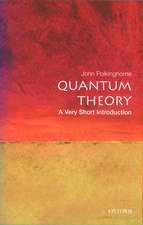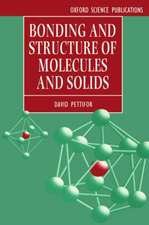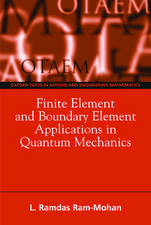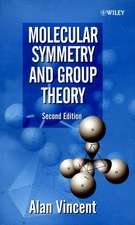Valency and Bonding: A Natural Bond Orbital Donor-Acceptor Perspective
Autor Frank Weinhold, Clark R. Landisen Limba Engleză Hardback – 16 iun 2005
Preț: 1257.33 lei
Preț vechi: 1462.01 lei
-14% Nou
Puncte Express: 1886
Preț estimativ în valută:
240.58€ • 251.19$ • 199.12£
240.58€ • 251.19$ • 199.12£
Carte tipărită la comandă
Livrare economică 04-18 aprilie
Preluare comenzi: 021 569.72.76
Specificații
ISBN-13: 9780521831284
ISBN-10: 0521831288
Pagini: 760
Ilustrații: 326 b/w illus.
Dimensiuni: 182 x 255 x 56 mm
Greutate: 1.67 kg
Editura: Cambridge University Press
Colecția Cambridge University Press
Locul publicării:Cambridge, United Kingdom
ISBN-10: 0521831288
Pagini: 760
Ilustrații: 326 b/w illus.
Dimensiuni: 182 x 255 x 56 mm
Greutate: 1.67 kg
Editura: Cambridge University Press
Colecția Cambridge University Press
Locul publicării:Cambridge, United Kingdom
Cuprins
Part I. Introduction and Theoretical Background: 1. The Schrödinger equation and models of chemistry; 2. Hydrogen atom orbitals; 3. Many-electron systems; 4. Perturbation theory for orbitals in the Hartree-Fock framework: the donor-acceptor paradigm; 5. Density matrices, natural localized and delocalized orbitals and the Lewis structure picture; 6. Natural resonance structures and weightings; 7. Pauli exchange antisymmetry and steric repulsions; 8. Summary; Part II. Electrostatic and Ionic Bonding: 9. Introduction; 10. Atomic and ionic orbitals; 11. Charge transfer and hybridization changes in ionic bonding; 12. Donor-acceptor theory of hybridization changes in ionic bonding; 13. Ionic/covalent transitions; 14. Ion-dipole and dipole-dipole bonding; 15. Beta ionic compounds of heavy alkaline earths; 16. Ionic bonding in D-block elements; 17. Summary; Part III. Molecular Bonding in the S/P-Block Elements: 18. Introduction; 19. Covalent and polar covalent bonding; 20. Conjugation and aromaticity; 21. Hyperconjugation; 22. Hypervalency; 23. Hypovalency; 24. Summary; Part IV. Molecular Bonding in the D-Block Elements: 25. Introduction; 26. Lewis-like structures for the D-block; 27. Hybridization and molecular shape; 28. Covalent and polar covalent bonding; 29. Coordinative metal-ligand bonding; 30. Hypervalent bonding; 31. Hypovalency and agostic interactions; 32. Conjugative and hyperconjugative effects; 33. Multi-electron coordination; 34. Vertical trends in transition metal bonding; 35. Summary; Part V. Supramolecular Bonding: 36. Introductory overview of intermolecular forces; 37. Hydrogen bonding; 38. Charge transfer complexes; 39. Transition state species; 40. Coupling of intra- and intermolecular interactions; 41. Summary; Appendices.
Recenzii
'The authors are clearly leaders in the field. … the book is well-written with vast numbers of illustrations as well as very useful worked examples. The impressive level of detail for individual systems can sometimes mask the underlying story, but salvation usually comes in the form of incisive summaries at the end of various major sections. This graduate-level book will be particularly useful to those who wish to understand NBO-based arguments presented in the literature and it is likely to be an invaluable resource for anyone who runs, or wishes to run, NBO analysis for themselves.' Chemistry World
'… the authors present some of the most intuitive classical concepts of quantum chemistry in an updated and transparent fashion … The book also contains an interesting discussion of hydrogen-bonding, which may in particular be recommended to biochemists. … definitely requires a careful study … chapter after chapter. The reward will be a deep immersion into the world of modern chemical bonding theory, illustrated for a large number of model systems, and supplemented by carefully worked out examples. … recommended for students and researchers in solid-state physics and materials science.' ChemPhysChem
'… the authors present some of the most intuitive classical concepts of quantum chemistry in an updated and transparent fashion … The book also contains an interesting discussion of hydrogen-bonding, which may in particular be recommended to biochemists. … definitely requires a careful study … chapter after chapter. The reward will be a deep immersion into the world of modern chemical bonding theory, illustrated for a large number of model systems, and supplemented by carefully worked out examples. … recommended for students and researchers in solid-state physics and materials science.' ChemPhysChem
Descriere
The first modernized overview of chemical valency and bonding theory, based on current computational technology.











